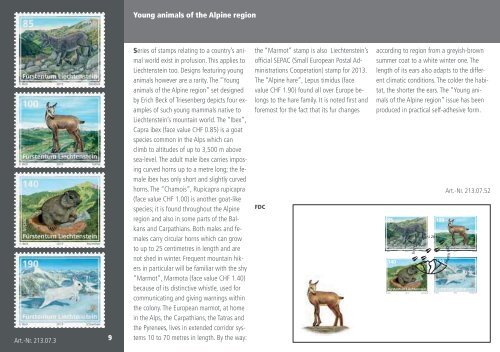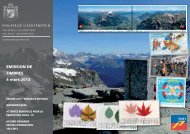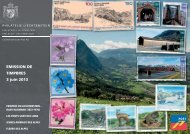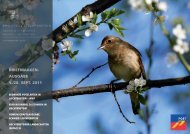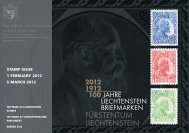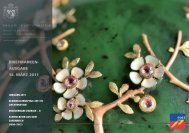Stamp Issue 3 June 2013 (5MB) - Philatelie Liechtenstein
Stamp Issue 3 June 2013 (5MB) - Philatelie Liechtenstein
Stamp Issue 3 June 2013 (5MB) - Philatelie Liechtenstein
Create successful ePaper yourself
Turn your PDF publications into a flip-book with our unique Google optimized e-Paper software.
Young animals of the Alpine regionArt.-Nr. 213.07.39Series of stamps relating to a country’s animalworld exist in profusion. This applies to<strong>Liechtenstein</strong> too. Designs featuring younganimals however are a rarity. The “Younganimals of the Alpine region” set designedby Erich Beck of Triesenberg depicts four examplesof such young mammals native to<strong>Liechtenstein</strong>’s mountain world. The “Ibex”,Capra ibex (face value CHF 0.85) is a goatspecies common in the Alps which canclimb to altitudes of up to 3,500 m abovesea-level. The adult male ibex carries imposingcurved horns up to a metre long; the femaleibex has only short and slightly curvedhorns. The “Chamois”, Rupicapra rupicapra(face value CHF 1.00) is another goat-likespecies; it is found throughout the Alpineregion and also in some parts of the Balkansand Carpathians. Both males and femalescarry circular horns which can growto up to 25 centimetres in length and arenot shed in winter. Frequent mountain hikersin particular will be familiar with the shy“Marmot”, Marmota (face value CHF 1.40)because of its distinctive whistle, used forcommunicating and giving warnings withinthe colony. The European marmot, at homein the Alps, the Carpathians, the Tatras andthe Pyrenees, lives in extended corridor systems10 to 70 metres in length. By the way:the “Marmot” stamp is also <strong>Liechtenstein</strong>’sofficial SEPAC (Small European Postal AdministrationsCooperation) stamp for <strong>2013</strong>.The “Alpine hare”, Lepus timidus (facevalue CHF 1.90) found all over Europe belongsto the hare family. It is noted first andforemost for the fact that its fur changesFDCaccording to region from a greyish-brownsummer coat to a white winter one. Thelength of its ears also adapts to the differentclimatic conditions. The colder the habitat,the shorter the ears. The “Young animalsof the Alpine region” issue has beenproduced in practical self-adhesive form.85Fürstentum <strong>Liechtenstein</strong>E. Beck <strong>2013</strong> Steinbock140Fürstentum <strong>Liechtenstein</strong>Ersttag 3. Juni <strong>2013</strong>E. Beck <strong>2013</strong> Murmeltier100Fürstentum <strong>Liechtenstein</strong>E. Beck <strong>2013</strong> Gämse190Art.-Nr. 213.07.529490 VaduzFürstentum <strong>Liechtenstein</strong>E. Beck <strong>2013</strong> Schneehase


